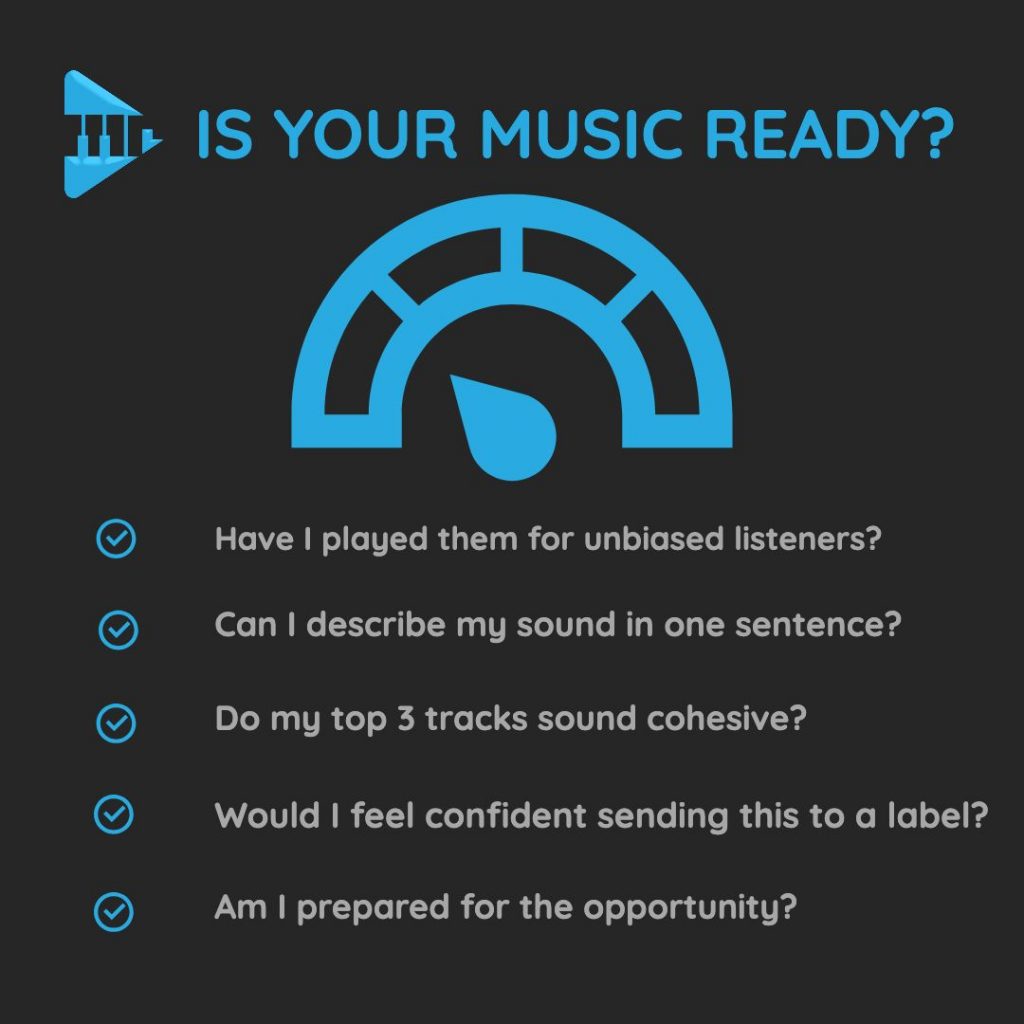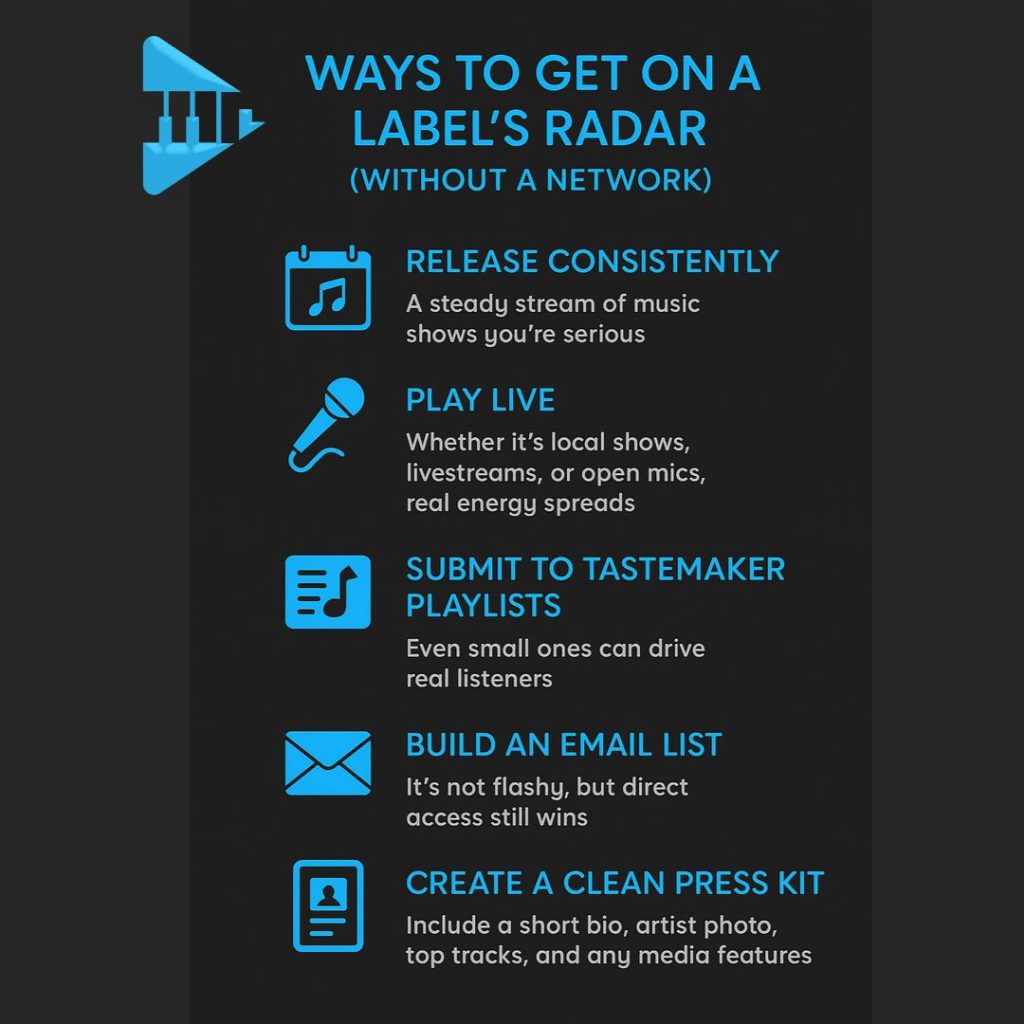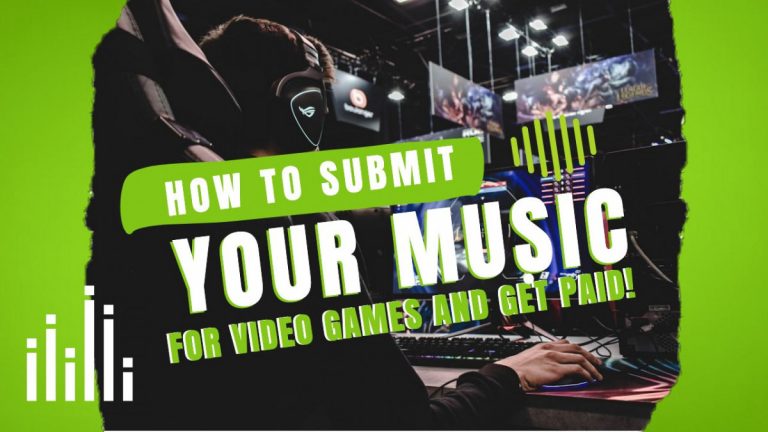Table of Contents
ToggleTL;DR (Key Takeaway):
To get signed by a record label in 2025, you need more than talent. You need proof. Labels look for artists already in motion: with a unique sound, consistent releases, and real audience engagement. But signing isn’t the only path. Platforms like Melody Rights help independent artists license music, collect every royalty, and stay in control without waiting for permission.
Why Getting Signed Feels So Out of Reach
You’ve done what most won’t. You’ve stayed the course, released your music, and shown up online. You’ve built from scratch with no shortcuts, no team behind the curtain.
Still, no replies or label emails. Just the quiet space between effort and recognition.
You’re not looking for a handout. You just want to understand what it really takes, because the answers out there feel scattered. One minute it’s all about your TikTok numbers, the next it’s sync, streams, or brand partnerships. Meanwhile, you’re still trying to finish your next track.
Here’s the part no one likes to say: in 2025, talent doesn’t get you signed. Proof does.
Labels are looking for artists who are already in motion. Building something, earning something, and showing they can move with or without help.
This guide will show you how to get signed by a record label in 2025 by building momentum that attracts real industry attention.
What Labels Are Really Looking for in 2025
If you’re banking on talent alone, you’ll be waiting a while.
Labels aren’t here to develop artists from scratch. They’re looking for momentum. Proof that you’ve already built something worth backing. That includes steady releases, real engagement, and a clear identity.
This is usually handled by A&R, short for Artists and Repertoire. Their job is to scout talent, shape releases, and bring new artists into the system. But in 2025, they’re not digging through demos or showing up at open mics. They’re online, tracking the artists who already have movement.
Here’s what they’re scanning for:
- A consistent sound and visual brand
- An active, engaged audience (even if small)
- A presence that feels ready – from your link-in-bio to your latest release
- Signs you can keep growing with or without a deal
You don’t need to go viral. But you do need direction. Labels want to see a spark they can amplify, not one they have to start from scratch.
How to Create Music That Gets You Signed
Making great music without much response can feel like shouting into the void.
You put your best work into a track, hit publish, and hope it lands. Most of the time, it doesn’t. Not because it’s bad, but because the system is noisy.
Getting noticed takes intention, not just effort.
Your songs can’t just sound decent. They have to hold weight. They need to stop someone mid-scroll, make them play it twice, leave a mark.
Labels are listening for:
- A defined sound. Not boxed in, but recognisable
- Music that reflects who you are, not what’s trending
- Quality production that makes each track feel finished
- Hooks and moments that stay with listeners
- A sense of direction. Something that feels like part of a larger path
You don’t need a huge catalogue. You don’t need to chase trends. But you do need to be intentional. If your production isn’t there yet, work with someone who gets your sound.
Trade time, find your circle, build with care.
Is Your Music Ready? A Quick Self-Check
Before you reach out to labels, ask yourself:
- Can I describe my sound in one sentence?
- Do my top three tracks sound cohesive and complete?
- Have I played these songs for listeners who don’t owe me feedback?
- Would I feel confident sending this to someone I respect?
- If a label rep found me tomorrow, would I feel prepared?
If you’re serious about how to get signed by a record label, your sound, setup, and presentation all need to be tight.

The clearer your sound and setup, the easier it is to land real opportunities. Especially sync deals. That’s why Melody Rights helps artists lock in their rights and get music pitch-ready from day one.
If the answers aren’t clear, that’s okay. That’s not failure. That’s focus. It’s where you sharpen before stepping into bigger rooms.
Get this right, and you’re not just putting out songs. You’re building something people can’t ignore.
How to Get Noticed by a Record Label on Social Media
Social media isn’t the whole game, but it’s often the first thing a label sees.
If your music catches someone’s ear, their next move isn’t to reply, it’s to look you up. They’ll check your Instagram, your TikTok, your link-in-bio. If what they find feels messy, inactive, or unclear, that interest usually ends there.
You don’t need to be everywhere. But you do need to show up with intention.
The same way a label checks your profile, so do sync agents and music supervisors. Melody Rights makes sure your music is set up for both, with rights and metadata that actually get you seen.
What Labels Look for on Your Profile
- A clear bio. Let people know what you do and where to find your music
- A consistent visual style. It doesn’t need to be polished, just intentional
- Regular posts. Doesn’t mean daily, just consistent enough to show you’re active
- Music clips that show range. Not just promo, but process, personality, performance
- A working link. One central place that leads to your latest music, press kit, or site (Find out how to create an EPK that really sells here).
Your profile is your storefront. Even if your numbers aren’t huge, labels want to see that you take your presence seriously. That you’re building trust with real people, not just chasing views.
If you’ve got ten loyal fans who share everything you drop, that means more than a thousand silent followers. Real connection beats reach.
How to Get a Record Label’s Attention Without Connections
Most artists don’t have someone on the inside.
No manager, no cousin at a label, no quiet industry plug. That’s normal, it doesn’t mean you’re out of the running.
What you can do is build momentum that stands on its own. That starts with consistency and clarity, in how you release music, how you present yourself, and where you show up.
Ways to Get on a Label’s Radar (Without a Network)

- Release consistently. A steady stream of music shows you’re serious
- Play live. Whether it’s local shows, livestreams, or open mics, real energy spreads
- Submit to tastemaker playlists. Even small ones can drive real listeners
- Build an email list. It’s not flashy, but direct access still wins
- Create a clean press kit. Include a short bio, artist photo, top tracks, and any media features
- Reach out with intention. A clear, respectful email with one standout track and a reason for the message is enough
If you’re cold-pitching a label, make it easy for them. Avoid big attachments and walls of text. Include one link to a song you believe in, a few lines about who you are, and a way to get in touch.
This isn’t about hoping someone picks you. It’s about showing that you’ve already started building something real.
Do You Really Need a Record Label?
Getting signed isn’t the only way forward. For some artists, it’s not even the best one.
A label can open doors. No question. They have budget, reach, and relationships that can accelerate your career. But there’s a trade-off, and it’s usually control.
When you sign with a label, you may lose ownership of your masters. You often split revenue in ways that heavily favor the label. You take an advance that has to be recouped before you see another cent. And if your music doesn’t perform fast enough, you might not get the support you expected.
That doesn’t mean labels are bad. It just means you need to know what you’re giving up, and what you’re getting.
Plenty of artists hit that moment where a label offer comes in and they’re torn.
It sounds good, but the terms are murky, the pressure is high. Deep down, they wonder if they could do it alone, just a little longer.
These days, more artists are choosing independence. They release music on their own terms, keep a larger share of their income, build their fanbase directly. Tools like Melody Rights make that independence real. You can register your rights, submit music for sync, and collect royalties across platforms without losing control or pulling down your releases.
The goal is the same whether you’re aiming for a deal or staying independent. Make music that moves people, and make sure you get paid for it.
Record Label vs Independent: Quick Comparison
| Record Label | Independent | |
| Ownership | Often give up masters | Keep 100% of your rights |
| Royalties | Smaller cut, after recoupment | Higher %, direct payments |
| Control | Label input on creative and release | You call the shots |
| Reach | Industry access and resources | Build slower, but own the base |
| Tools | Provided by label | Choose what works for you |
The truth is, getting signed should be a decision, not a dream. And it only works when you come to the table with leverage, clarity, and options.
If you’re not there yet, that’s fine. Keep building. And if you are, remember: you don’t need to hand over your power to move forward.
How Melody Rights Helps You Build Without a Deal
You’ve uploaded your tracks. Watched the streams tick up slowly. Maybe landed a few playlists. But the money? Barely moving.
That’s because streaming isn’t the only lane. And it’s not the one that pays best.
Sync placements in film, TV, ads, and games can bring in real income. In fact, sync royalties made up 17 percent of all publishing revenue in early 2022, totaling $178 million in just six months. But most independent artists aren’t set up to access that world.
Melody Rights helps change that.
It’s not a distributor. It’s a sync-first rights platform made for artists who want to license their music, get paid properly, and stay independent.
We’ve heard it before: “I didn’t even know sync was possible without a publisher.” The moment artists register their rights correctly, their music becomes eligible for real opportunities.
With Melody Rights, you can:
- Submit music for sync placements in shows, films, games, and branded content
- Register your rights the right way: PROs, ISRCs, splits, metadata
- Collect royalties across both master and publishing (Learn the difference here)
- Use it alongside your current distributor. No removals needed
- Keep full control of your catalog. No exclusivity. No hidden terms
Every day your music is online without a proper setup, you could be missing income.
You made the music. Let it earn like it should.
Your Career. Your Rights. Your Move.
No label? No problem. The truth is, you don’t need permission to build something powerful. You just need tools that work.
Melody Rights helps you license your tracks, collect every royalty you’re owed, and stay in control. – Without changing your release plans or chasing gatekeepers.
Start where you are. Use what you have. Keep every right.
Explore Melody Rights and take control today.
Frequently Asked Questions
How to get signed by a record label?
Start by building momentum on your own. Release great music consistently. Show you’ve got an identity, a loyal audience, and a plan. Labels want to see movement before they get involved.
Does it cost money to be signed to a record label?
No upfront cost, but there’s a trade-off. Labels often give advances that must be paid back before you earn royalties. You may also give up ownership of your masters. Here’s a deeper breakdown.
How do you pitch yourself to a record label?
Keep it short and sharp. Send a few clean links to your music.
Introduce who you are, what you’ve released, and why your music fits their roster. Do your research. Include your contact info.
How do I get in contact with a record label?
Most labels list contact info or submission forms on their website. But cold outreach only works if your music is ready and your online presence looks solid. A clean link-in-bio helps.
Can I still get sync placements without a label or publisher?
With Melody Rights, you can submit your music for sync in film, TV, games, and branded content. No label, no publisher, no exclusivity. Just a clear path to get your tracks heard and paid. You stay in control and keep 100 percent of your rights. Submit your music for film and TV here.
Will Melody Rights work with DistroKid, TuneCore, or CD Baby?
Yes. Melody Rights works alongside your distributor. It focuses on sync and royalty tracking, so you don’t need to take anything down or change your release strategy.
Your Music. Your Move.
You don’t need permission to build something powerful. You need the right tools, the right setup, and the drive to keep going when it’s quiet.
Melody Rights is here for that.
We help you license your music, collect every royalty, and stay in control. No deals. No gatekeepers. No compromises.
Start with what you have. Keep every right. Grow your career the way you choose.
Explore Melody Rights and move with clarity.



